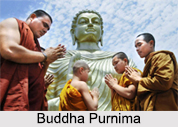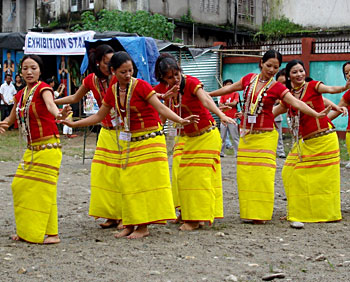 Indian Festivals and food have a deadly combination. Indian festivals are deficient without gorging scrumptious eatables. In contemporary India food is an integral part of festivity. During the Durga Pujas food remains to be an obvious choice. Apart from the Bhog, eating out is almost mandatory like Bhelpuri and Panipuri. Even during Navaratri, the mood of festivity is spread all over and food fiesta is observed. The tenth day, Dussehra, is considered as Vijayadasami. Vijayadasami is venerated as the day of victory, when people in the North burn effigies of Ravana, the evil power according to the sacred Hindu epic Ramayana and his younger brother, Kumbhakarna. In the South Goddess Saraswati is most famous and Navaratri is celebrated in South Indian households with a display of dolls. And these days are auspicious marking the epicurean delight of the Indian millions.
Indian Festivals and food have a deadly combination. Indian festivals are deficient without gorging scrumptious eatables. In contemporary India food is an integral part of festivity. During the Durga Pujas food remains to be an obvious choice. Apart from the Bhog, eating out is almost mandatory like Bhelpuri and Panipuri. Even during Navaratri, the mood of festivity is spread all over and food fiesta is observed. The tenth day, Dussehra, is considered as Vijayadasami. Vijayadasami is venerated as the day of victory, when people in the North burn effigies of Ravana, the evil power according to the sacred Hindu epic Ramayana and his younger brother, Kumbhakarna. In the South Goddess Saraswati is most famous and Navaratri is celebrated in South Indian households with a display of dolls. And these days are auspicious marking the epicurean delight of the Indian millions.
Whether it is at the eating outlets or in houses an eclectic approach is adopted as far as food is concerned. In addition to the scrumptious regional cuisines the food lovers also dig their teeth into fusion food. Several esteemed names in the hospitality industry take part in the Indian food festivals, bringing with them food items from almost all over the world, such as, Chinese, Mongolian, Italian, Mexican, et al. whether Navaratri or Durga Puja, the food journo meet their trajectories only in the food lovers street.
Diwali is fˆted on the third day of the festival, when the moon completely wanes and total darkness sets in the night sky. This day is also celebrated by worshipping Goddess Lakshmi. As Hindus worship Laxmi and pray for the blissful rain of wealth and prosperity, sweets make their way to the food loving Indians. Dry fruits and Kheer are served in plenty as fireworks cloud the Indian sky.
Hindus have festivals on the new and full moon. The festival on the New Year is called Pongal when the sun enters Capricorn around 12th of January. Pongal lasts for three days and sometimes lasts even longer. The first day is the Bhoga-Pongal is held when relatives and friends invite each other to entertainments and spend the time by enjoying with each other. Second day is the Perum Pongal which takes place in honour of the sun. Third day is the Mattu Pongal or the Cow Pongal. Early in the morning the cultivators sprinkle water on the corn of their fields. In the afternoon the cows and bulls are washed, their horns painted, they are dressed with trappings of leaves, flowers and coconuts. They are brought where the cow-keepers sprinkle saffron, water and mango-leaves upon them.
 As Cristes Maesse", or "Christ`s Mass" or Christmas celebrates the Nativity of Jesus Christ, founder of Christianity during the chilly wintry days the night is enlivened by carols, dances and the midnight mass, and preparation of dishes for the Christmas feast. The day is spent in visiting friends and relatives, and in feasting. These are generally Eurocentric habitual customs introduced by Europeans and followed by Christians, practically all over India. Christmas is celebrated with cakes made of rice flour, plantains and a feast. Commercialisation is however bringing more secular Christmas celebration to the public sphere. Days before the festival, markets have a colourful look as they are decorated with traditional Christmas trees, stars, images of Santa Claus, balloons and festoons.
As Cristes Maesse", or "Christ`s Mass" or Christmas celebrates the Nativity of Jesus Christ, founder of Christianity during the chilly wintry days the night is enlivened by carols, dances and the midnight mass, and preparation of dishes for the Christmas feast. The day is spent in visiting friends and relatives, and in feasting. These are generally Eurocentric habitual customs introduced by Europeans and followed by Christians, practically all over India. Christmas is celebrated with cakes made of rice flour, plantains and a feast. Commercialisation is however bringing more secular Christmas celebration to the public sphere. Days before the festival, markets have a colourful look as they are decorated with traditional Christmas trees, stars, images of Santa Claus, balloons and festoons.
Id Ul Fitr, an occasion for general goodwill is popular among Muslim sects. A 30-day fast of the month of Ramzan, is broken on Id-Ul-Fitr. It is broken with special prayers and festivities with sumptuous feasts. People embrace each other three times, as is laid down in the Holy Quran (The Holy Book of Muslims). The festival originated after proclaiming Ramadan as the period of fasting and austerity. Prophet Muhammad announced this day for celebrations to reiterate the feeling of Id-Ul-Fitr, brotherhood. Women prepare sweets at home. Vermicelli cooked in sweetened milk, is popular. People then get together for celebrations. Some people visit cemeteries and stay there for many hours. This is perhaps to honour their ancestors and to be with their spirits. To a devout Muslim, Id is a time to forget all past grievances.
Ramnavami falls on the ninth lunar day of the bright fortnight of Chaitra, a month in Hindu calendar, and is observed with great sanctity and fasting. It is a nine-day festival, coinciding with Vasant Navaratri. Devotees stay awake on the ninth night, in anticipation of Lord Rama`s birth and rock his image in cradles to celebrate his birth. For this festival, temples are decorated exquisitely, the image of Lord Rama is richly adorned and the Ramayana is read out in temples. Traditional worship begins with chanting Vedic mantras dedicated to Vishnu, and offering flowers and fruits to the God. Excerpts from the "Ramacharitamanas", praising Lord Rama, are also recited. Lord Rama`s devotees fast for nine days with fruit and milk, whilst some fast on the ninth day only. This is one of the five Mahavratas observed since ancient times.



















